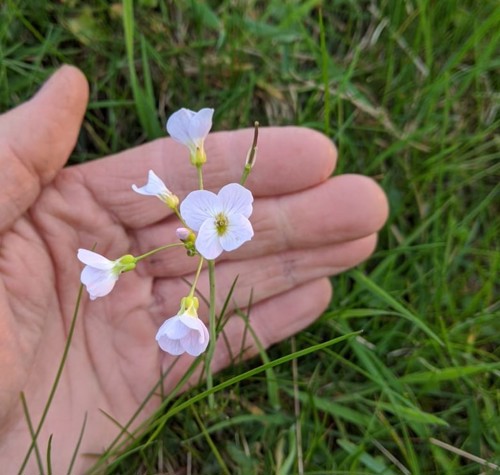



The Grassroots Club members of the Cumbria Farmer Network have set up a field lab to look in more detail how to overcome the challenges they face in establishing herbal leys and diverse swards in their wet conditions in the uplands.
Ten Farmers will evaluate their swards over 3 years to see how their management of soils and grazing/cutting regimes, in low-input systems, under different weather conditions and seasons affect the species composition and performance of their diverse permanent pastures and long term leys.
This field lab will be looking into productive, species rich swards consisting of over 15 herb, legume and grass species.
The benefits of multi-species or diverse swards are well researched, and include:
However, these seed mixtures are expensive and there is little experience about how to establish and manage them in the climate and soil conditions of north-west England.
A series of extreme wet and dry periods over the past 10 years due to climate change has made establishment of grazing and cutting swards of all types difficult. Wet conditions, in particular result in soil poaching favouring undesirable species like rushes, docks and thistles.
During the trial each farmer will keep records of:
The organic matter, nutrient content, texture, pH, and profile of the soil will be measured at the beginning and end of the project and the data compared.
From late May and the second week of June, the group are busy doing 1m x 1m quadrat assessments, sharing photos via WhatsApp to help each other identify species within the quadrats, which have included cuckooflower and thyme-leaved speedwell.
Information is being recorded on management (livestock, cutting, topping, manure application, liming, etc), vegetation and VESS via the free Survey123 app or data sheets - a template can be found in the 'Documents' section of this page.
Quadrat location is recorded either through the app, GPS on mobile phones or by measuring paces and direction lined up to features in the field such as gateways and trees. VESS samples are taken outside of the quadrats so to not disturb the plants growing in it.
The group are also taking photos from directly above the quadrats and for VESS tests.
The group met at Newton Rigg to discuss their reflections from the monitoring done so far.
Due to the really wet soil conditions since September last year, only 3 farmers have managed to practice the data collection technique and use the tools.
Main learning points:
The meeting helped to clarify what the farmers are trying to understand about their diverse ley in their farm situation.
Some of the group met at Gowbarrow Hall, Ullswater, for a training in plant ID and recording workshop with Lisa Norton (field lab researcher).
We learned:

The group have agreed to keep the following records of management throughout project:
Field/ farm level measures:
The group intend to establish a baseline at the start of the project for (at least) one pasture field on each of the farms. They will compare the fields across time and look at how different management on different farms influences the composition of the sward and soil in each pasture.
Baseline data:
Productivity will be measured in comparison with previous offtake from the fields under study (when not sown with diverse swards) and where appropriate with non-diverse swards under management by the same or neighbouring farms. Species richness of swards and the desirability of the species present together with sward and soil parameters will be compared with previous data (where available) and with extensive data held on pastures by the researcher. We will also seek to integrate with other data/possible sampling on the nutritional quality of sward species.
September 2019
May 2020
September 2020
September 2021
May 2021
September 2021
October 2021
February 2022

The Farmer Network
I’ve worked for The Farmer Network on a part-time basis for 10 years, fitting it around other work and also time on the home smallholding producing beef, eggs, fruit and salad crops. I organise events and farmer group meetings and co-ordinate the Business Support for Young People project, enabling them to get the most from the advice and support available from the Prince’s Trust and local expertise. I also co-ordinate the Farmer Network input into the Hill Sheep Health project, Farmers against Parasites, working with hill farmers, in partnership with the Yorkshire Agricultural Society and the London and Liverpool Vet schools. For a number of years I managed the overall Farm Trials project with support from the Prince’s Countryside Fund and other organisations and I am currently trying to develop new farmer-led projects to build on what we have already learned."

CEH